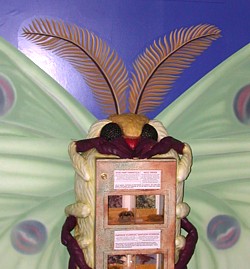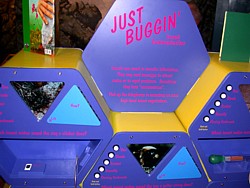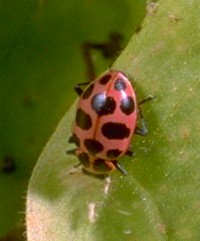

 |
|
SPRING
2003 CONTENTS
| |
|
2003 Environmental
Academy |
|
|
2003
ENVIRONMENTAL ACADEMY
|
|
| Kentucky has one of the most diverse combinations of ecosystems in the United States. Our state has forests and mountains in the east, plains in the west, a complex cave system, and a staggering array of lakes, rivers, and streams. This summer, Kentucky educators will have a unique opportunity to explore Kentucky's incredible ecosystem diversify first hand. | |
|
Exploring Kentucky's Ecosystems: A Road Trip Across Kentucky will be a 5-day environmental academy offered June 16-20, 2003. Academy participants will tour the state with stops at the Daniel Boone National Forest, Mammoth Cave National Park, Raven Run Nature Sanctuary, and other natural areas. |

|
|
Along the way, and with the help of some of Kentucky's best science and education experts, participants will investigate the wildlife, plantlife, soils, and (of course) insects associated with each ecosystem, focusing on ways to bring this information back to the classroom. Enrollment for this academy is limited to 30, and some participants will qualify for a stipend to attend, so sign up soon. For more information: contact Stephanie Jenkins at the Tracy Farmer Center For the Environment at (859) 257-4974. |
|
|
BUGGIN'
AT THE CHILDREN'S MUSEUM
|
|
Who's buggin'? We're Buggin'. The Lexington Children's Museum and the University of Kentucky Department of Entomology have teamed up to bring a unique experience to Central Kentucky, and we want everyone to come see it. |
|
| "Just Buggin'" is the name of a brand-new exhibit at the Lexington Children's Museum. Featured in this exhibit are live insects, mounted insects, and an interactive demonstration of insect acoustics. Oh -- you'll also find a giant luna moth. | |

|
The centerpiece of Just Buggin' is a giant luna moth sculpture. This sculpture is not only accurate, but functional: built into it are aquaria that house live arthropods. Right now, the rotating Just Buggin' arthropod crew features a Chilean Rose-Hair Tarantula, an Emperor Scorpion, and a giant African millipede. Kids love to get up-close-and-personal with these amazing animals. Hurry, though: the insects change periodically so that we can showcase lots of different creatures. |
| Pictured on the right is the amazing Just Buggin' Insect Acoustic Demonstration Station. This device allows kids to listen to the sounds that insects make, and then duplicate those sounds using musical instruments. For instance: a small snare drum replicates the sound of a male stonefly. Male stoneflies bang their abdomens on rocks to attract females. |
 |
|
The Lexington Children's Museum
is located on Short Street in Downtown Lexington. Visit their website
for hours and ticket prices: Come visit Just Buggin' soon! You never know when it's going to just "bug off." (Sorry.) |
|
|
CRITTER
OF THE MONTH: PINK LADY BEETLE
|
||
|
You may have noticed the lady beetle at the top of this newsletter. That lady beetle is not just any lady beetle. It's the Pink Lady Beetle, Coleomegilla maculata. We have many species of lady beetles in Kentucky. The pink lady beetle, also called the "12-spotted lady beetle," is just one of them. It also happens to be one of the most common, and it is native to Kentucky. |
 Pink Lady Beetle (R. Bessin, 2000) |
|
|
Like most lady beetles, the pink lady beetle is a predator and feeds on aphids, insect eggs, and other small, slow-moving arthropods. Pink lady beetles are frequently found in field crops such as tobacco, corn, and soybean. They are one of the "good guys" who help reduce pest numbers. Unfortunately, another lady beetle species, the exotic Asian Lady Beetle, often feeds on native lady beetles like the pink lady beetle. Read more about pink lady beetles and other lady beetle species in the Lady Beetles entry of the Critter Case Files. |
||
| Critter Of The Month is a new Wee Beasties feature. Each month, we will feature one of the critters from the Critter Case Files, University of Kentucky's on-line field guide to insects, spiders, and related critters. | ||
|
||||||||
| The Entomology Department will
be present with displays, insects, and information at the following events
and locations during Spring and Summer 2003:
|
|
|||
| If you have ideas, experiences,
or information that you would like to share or would like information about
educational resources available through the University of Kentucky, Department
of Entomology, write, phone, or email:
Blake Newton View and print Wee Beasties in the Adobe Acrobat (tm) PDF format. The Adobe Acrobat (TM) PDF format allows you to download, view, search, and print, while maintaining the original printed look of the document. You will need the (free) Adobe Acrobat Reader plug-in to read PDF documents.
Black and white images used with permission from http://www.arttoday.com/ Photos courtesy of R. Bessin & B. Newton, Department of Entomology, University of Kentucky
Educational
Programs of the Cooperative Extension Service serve all people regardless
of race, color, age, sex, religion, disability, or national origin.
UNIVERSITY OF KENTUCKY, KENTUCKY STATE UNIVERSITY, DEPARTMENT OF AGRICULTURE AND KENTUCKY COUNTIES COOPERATING. |